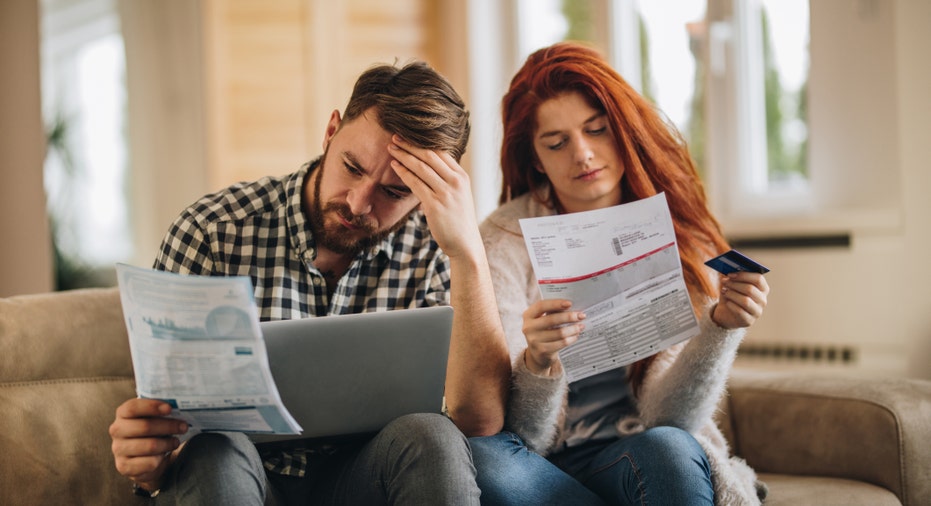What is the best way to tackle credit card debt?

American are doing a good job addressing credit card debt – but there’s always room for improvement. (iStock)
U.S. consumers are making headway with their credit card debt, but there's still a long way to go to becoming debt-free.
Overall U.S. cardholder debt fell by $10 billion in the third quarter of 2020, following a steep $76 billion decrease in the second quarter, according to the New York Federal Reserve. Their analysis noted the global COVID-19 pandemic and the resulting government lockdowns fueled more debt pay downs as consumers limited their spending.
Despite the progress, Americans still face an uphill climb to clear their balances, especially with outstanding credit card debt standing at $756 billion, according to Experian, and average household credit card debt at $5,315.
“Most of the women I work with got their first credit card in college before they learned to budget or spend intentionally,” said Erin Gobler, a Madison, Wisconsin-based financial coach for millennial women. “Unfortunately, many of them end up overspending and carrying that debt with them for years.”
4 ways to tackle credit card debt
If you're looking to pay off debt, you may want to start by using a free credit monitoring service. Credible can introduce you to credit monitoring services that alert you to potential issues — like fraud — and give you a thorough look at your credit score and activity.
After signing up for a credit monitoring service, here are four other ways to tackle credit card debt.
- Make a list
- Get a balance transfer credit card
- Get a debt consolidation loan
- Pay off debt with the snowball and avalanche methods
1. Make a list
The first step should be sitting down with a spreadsheet and making a list of each of your debts, including the lender, balance, interest rate, and minimum monthly payment.
“This forces you to look at the big picture of your debt rather than facing each one as an individual monthly bill,” Gobler said.
Once you make your list and determine a payment strategy, you may want to consider some loan options. Multi-lender marketplace Credible has information on various types of credit cards, including balance transfer credit cards (which you'll learn about more below). Use their free tools to compare balance transfer cards and buy yourself some time to pay off debt.
2. Get a balance transfer credit card
Transferring an existing credit card debt to a new credit card offering 0% interest on balance transfers is another good option to explore.
“Getting a 0% balance card will give you more time to pay down your credit card balance without interest eating up your monthly payments,” said Andrea Woroch, a money-saving expert and founder of the personal finance website AndreaWoroch.com. “Some cards even come with a cashback bonus for signing up.”
Visit an online marketplace like Credible to view multiple balance transfer credit card options in seconds.
HOW TO GET A BALANCE TRANSFER CREDIT CARD
3. Get a debt consolidation loan
You can also make paying off your debt more manageable by taking out a debt consolidation loan.
“Like debt refinancing, a debt consolidation loan is a personal loan that lets you combine all your existing credit card balances into one monthly payment,” said Rafael Rubio, president of Stable Retirement Planners, in Southfield, Michigan.
Explore your personal loan options on Credible, where you can use the platform’s personal loan calculator to fund the best personal loan rates.
9 OF THE BEST DEBT CONSOLIDATION COMPANIES
4. Pay off debt with the snowball and avalanche methods
Debt snowball
If you have multiple credit card debts, you can leverage a paydown strategy called the "debt snowball method."
“In this case, you pay down a single credit card balance at a time and make the minimum payments on the rest of your cards,” said Rubio. “The strategy is to pay off your smallest balance first and then go on to the next smallest balance. This is a good method to give yourself a boost by tackling one card at a time. The small wins of paying off a card will feel good and motivate you to pay off the next one.”
The trick is to hide the cards you pay off. “Don’t start another balance before you pay off the others,” Rubio added.
Debt avalanche
Cardholders can also pay down debt using the debt avalanche method.
“This strategy is like the debt snowball method, except you start paying down the balance with the highest interest rate first,” Rubio said. “While it may take you a little bit longer to start to see progress this way, you'll save money overall because you'll pay less in interest charges over time.”
DEBT SNOWBALL VS. DEBT AVALANCHE: WHAT'S THE DIFFERENCE?
The takeaway on credit card debt
The major takeaway here: there are easy ways to pay off debt and save you money in the end. It's always a good idea to use a credit monitoring service to ensure you're aware of your credit profile.
The last tip on curbing card debt? Don’t keep using your credit card as you pay down the debt.
“If you’re still using your card, it becomes more challenging to pay down your card balances,” Woroch said. “Instead, commit to stop using your card and make a plan to get out of debt.”